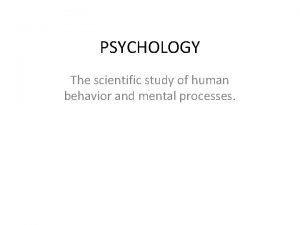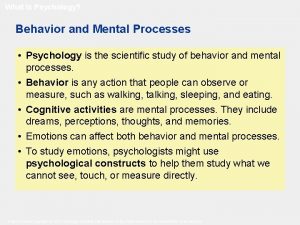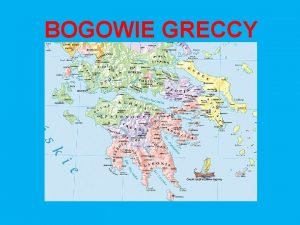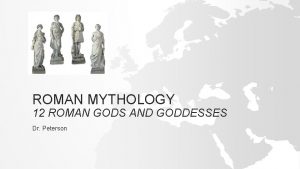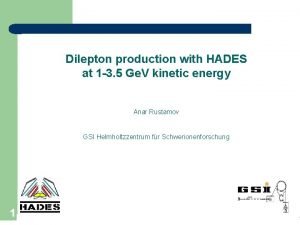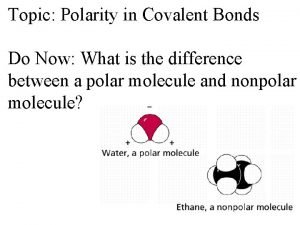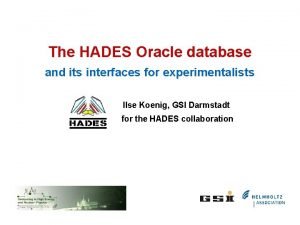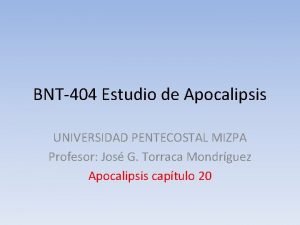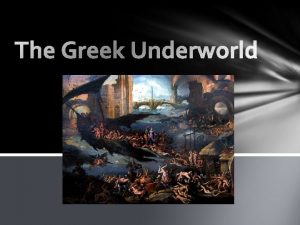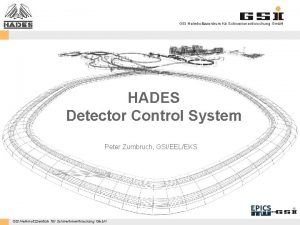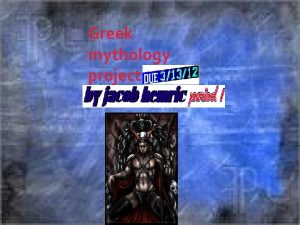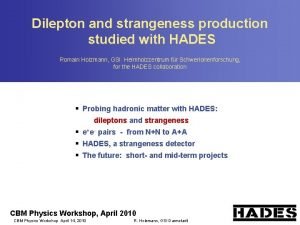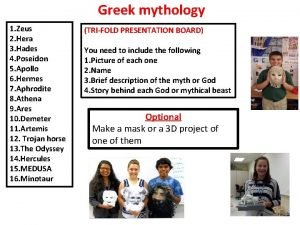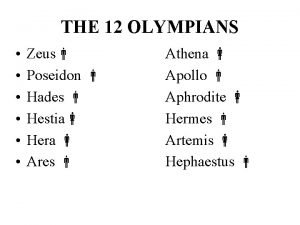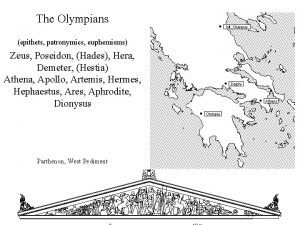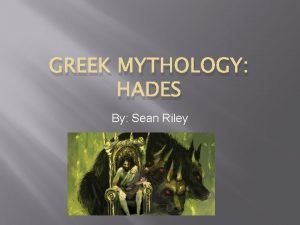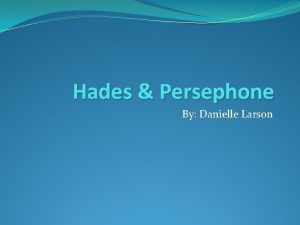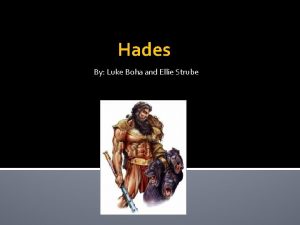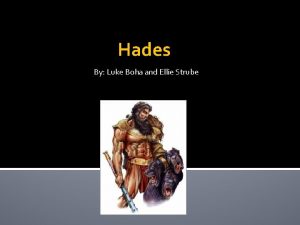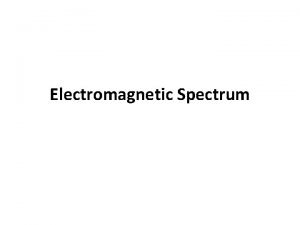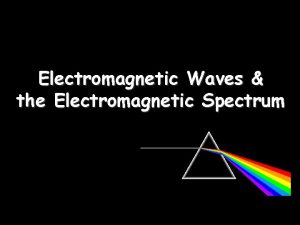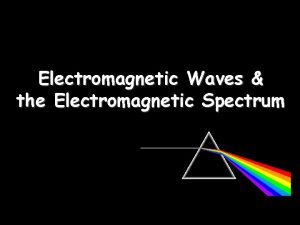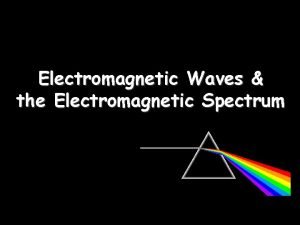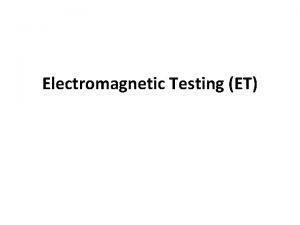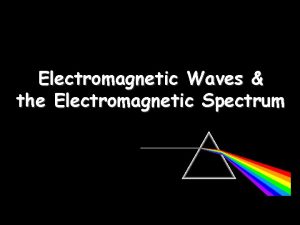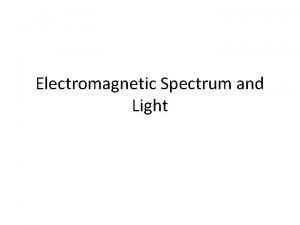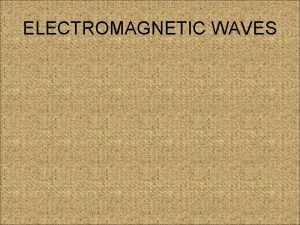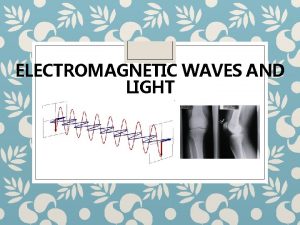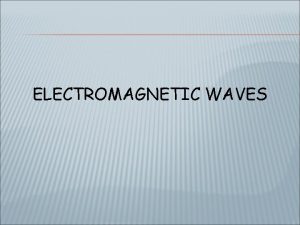Study of electromagnetic processes with the HADES dielectron



























- Slides: 27

Study of electromagnetic processes with the HADES dielectron spectrometer : in elementary pp and quasi-free pn experiments Side View Béatrice Ramstein Institut de Physique Nucléaire France START Béatrice Ramstein, IPN Orsay, France Hadron 2009, Florida

High Acceptance Di-Electron Spectrometer experiments at GSI Main goal: search for vector meson medium modifications in 1 -2 AGe. V range (A. Kugler’s talk) Side View Why elementary reaction experiments? START Béatrice Ramstein, IPN Orsay, France ü Reference for heavy-ion measurements ü Test of models in « vacuum » conditions ü Selectivity to different dilepton sources (exclusive channels) Hadron 2009, Florida 2

Outline Introduction: motivations of HADES experiments in elementary reactions Discussion of recent HADES pp and dp (quasi-free pn) data E=1. 25 Ge. V – Exclusive hadronic processes ( , production) – Inclusive dilepton production – Exclusive leptonic channels: pp ppe+e- Comparison to models: – Resonance model – One Boson Exchange models Conclusions - perspectives of pion induced reactions Béatrice Ramstein, IPN Orsay, France Hadron 2009, Florida 3

HADES results in C+C reactions at 1 and 2 AGe. V ü dilepton spectra reproduced by different transport models with no (or small) medium effects end of DLS puzzle ü but with different yields for the individual dilepton sources ! ü specific role of NN NNe+e- (Bremsstrahlung) Ne+e- (Dalitz decay) 1/N 0 d. N/d. M HADES data HSD IQMD C+C 2 A Ge. V N G. Agakichiev et al. , Phys. Rev. Lett 98, 052302 (2007) G. Agakishiev et al. , PLB 663 (2008) 43 Me+e- (Ge. V/c 2) E. Bratkovskaya et al. NPA 807(2008)214 Béatrice Ramstein, IPN Orsay, France Me+e- (Ge. V/c 2) M. Thomere et al. PRC 75, 064902(2007) Hadron 2009, Florida 4

NN Bremsstrahlung and Dalitz decay NN * NNe+e- q 2 = M *2 > 0 Quantum interference Ne+e- (BR from QED = 4. 2 10 -5 not measured ) N, graphs N N nucleon graphs Time-Like electromagnetic form factors graphs two recent full quantum mechanical One Boson Exchange calculations: 1) R. Shyam & U. Mosel, PRC 79 (2009) 03520 2) L. P. Kaptari, B. Kämpfer, NPA 764 (2006) 338 nucleon graphs Mee(Ge. V/c 2) pp dominated by graphs nucleon graphs (Bremsstrahlung) larger in pn than in pp collisions Yields differ in the two models by factors 3 -4 Béatrice Ramstein, IPN Orsay, France Hadron 2009, Florida 5

Elementary reactions measured by HADES ü Dalitz decay : pp E=1. 25 Ge. V E< production threshold ü NN Bremsstrahlung: dp (pn) E=1. 25 AGe. V ü °, production pp E= 2. 2 Ge. V ü /ω production: pp E=3. 5 Ge. V ( A. Rustamov ‘s talk) HADES Specific instrumental tools: LH 2 target, p/d beams, Forward Wall d 2 Forward Wall m spectator proton 7 m Béatrice Ramstein, IPN Orsay, France Hadron 2009, Florida ( 0. 5 – 7 ) 6

Step 1: hadronic channels pp elastic scattering tracking, efficiencies, resolutions pp pp °, pp pp consistency of hadronic and leptonic reconstructions pp pn +, pp pp °, pp pp check of resonance model ( dilepton cocktail) Béatrice Ramstein, IPN Orsay, France Hadron 2009, Florida 7

exclusive pion production channels measured by HADES Ø absolute normalisation from elastic scattering ØVery good agreement with resonance model Teis et al. ZPA 356(1997) 421 + refinements in both isospin channels ØConsistent picture at E=1. 25 Ge. V and 2. 2 Ge. V Ø important check for dilepton analysis ( ° and resonances are dilepton sources !) ar. Xiv: 0909. 3399[nucl-exp] Béatrice Ramstein, IPN Orsay, France Hadron 2009, Florida 8

and production : acceptance corrected results production: 1 exchange decay: 1+1. 35 cos 2 Neutron angular distribution in CM + angular dist. in ( + , p) ref. frame n ++ n p p + + p ++ Total cross sections compared to systematics pp pp Béatrice Ramstein, IPN Orsay, France Hadron 2009, Florida 9

Step 2: inclusive e+e- analysis Béatrice Ramstein, IPN Orsay, France Hadron 2009, Florida 10

Analysis steps : one example Forward Wall (np selection): 1. Mult > 0 2. search for particle with 1. 6 Ge. V < p < 2. 6 Ge. V y ar n i im el r p (e+, e-) pair cuts: 1. track and ring quality 2. identification 3. background rejection cuts 4. openangle > 9°. Combinatorial background: like sign pairs NCB=N++ + N-Note: ~1500 pairs above ° Nice S/B ratio Béatrice Ramstein, IPN Orsay, France efficiency corrections: normalisation by elastic scattering measurement Hadron 2009, Florida

Results for pp reaction at 1. 25 Ge. V PLUTO ROOT-based event generator I. Fröhlich et al, arxiv: 0708. 2382; I. Fröhlich et al, arxiv: 0909. 5373 resonance model: Teis et al. Zeit. Phys. A 356(1997) 421 + refinements subm. to PRL 0910. 5875[nucl-ex] q ° Dalitz decay ° = 4. 5 mb branching ratio ° → e+e- 1. 2 % q Dalitz decay : =3/2 ° = 6. 75 mb branching ratio →Ne+e- (QED : 4. 2 10 -5) Time-like N- transition electromagnetic form factors Iachello and Wan p GM(q 2) p Resonance model results: ° Dalitz)+ effect of Iachello FF p p + * q 2 = M 2 inv(e+e-) = M *2 > 0 Béatrice Ramstein, IPN Orsay, France e+ GM(0)~3 0. 6 m 2 e-Hadron 2009, Florida 12

Quasi-free « pn » dilepton spectra Comparison to resonance model subm. to PRL 0910. 5875[nucl-ex] Dalitz q ° Dalitz decay ° = 8. 6 mb branching ratio ° → e+e- 1. 2 % q Dalitz decay : =3/2 ° = 12. 9 mb branching ratio →Ne+e- (QED : 4. 2 10 -5) New features with respect to pp reactions: ü participant neutron Fermi momentum ( Paris potential) ü contribution ° Dalitz (BR ~ 4. 2 10 -5) + + effect of Iachello FF Béatrice Ramstein, IPN Orsay, France Additionnal sources with respect to pp? NN Bremsstrahlung is absent !! Check with full One Boson Exchange calculations Hadron 2009, Florida 13

pp/pn reactions at 1. 25 Ge. V: Comparison to simulations with OBE differential cross sections : R. Shyam & U. Mosel, PRC 67 (2003) 065202 L. P. Kaptari, B. Kämpfer, NPA 764 (2006) 338 Kaptari & Kämpfer Shyam & Mosel pp OK with Shyam & Mosel overestimated by K&K Béatrice Ramstein, IPN Orsay, France HADES np data: a new puzzle ? ? Hadron 2009, Florida 14

Step 3: exclusive pp ppe+e- analysis Béatrice Ramstein, IPN Orsay, France Hadron 2009, Florida 15

exclusive analysis : pp ppe+e- at 1. 25 Ge. V using pe+e- events (i) Mee>140 Me. V/c 2 ry X simulation Selection of pp ppe+e- channel is efficient pr eli m ina pp pe+e-X missing mass M HADES data mp MX(Ge. V/c 2) pp p + pp ° pp e+e. Dilepton mass distribution in very good agreement with ° and Dalitz decay 200 events for Me+e- > 140 Me. V/c 2 pp p + ppe+e- pr el consistent with inclusive dilepton analysis Béatrice Ramstein, IPN Orsay, France im in ar y 0. 2 Hadron 2009, Florida 16

exclusive analysis (ii) pp ppe+e- at 1. 25 Ge. V No acceptance corrections ! reconstructed by (p, e+, e-) prelim 2 indistinguishible protons p p 1 + p inary (p 1, e+, e-) p 2 (p 2, e+, e-) e+ q 2=M 2 inv(e+e-)=M 2 * e- (p, e+, e-) invariant mass (Ge. V/c 2) acceptance corrected simulation of production + Dalitz decay (cf hadronic channels) prelim inary dominance of pp p + p pe+e- room for pp Bremsstrahlung contribution? Béatrice Ramstein, IPN Orsay, France cos( pe+e-) Hadron 2009, Florida 17

exclusive analysis pp ppe+e- at 1. 25 Ge. V: helicities Dalitz decay: + p * pe+e-: helicity angle e only transverse * (if Coulomb interaction is neglected) * + Helicity distributions * e e d /dΩe~ 1+cos 2 True helicity from pe+e- events: * in ref. frame acceptance corrected fit 1+B cos 2 B=1. 11 0. 32 prelim inary cos e+ N Pseudo-helicity from e+e- events: * in CM acceptance corrected fit 1+B cos 2 B=1. 51 0. 51 prelim in ary to be investigated in heavy-ion reactions cos Béatrice Ramstein, IPN Sensitivity to relative contributions of Dalitz decay/ pp Bremsstrahlung? Orsay, France 18 Hadron 2009, Florida

Conclusions: elementary reactions with HADES hadronic channels (E=1. 25 Ge. V, 2. 2 Ge. V ): – precise results on production mechanisms of dilepton sources ( °, , ) – consistency checks for dilepton analysis pp/quasi-free pn inclusive dilepton spectra E= 1. 25 Ge. V – reference for heavy ions (A. Kugler’s talk) critical tests for theory a consistent description of dilepton production in all systems is needed !! – pp data as expected from °/ contribution (limited) sensitivity to hadron electromagnetic structure – pn data unexplained new puzzle ! Very new pp ppe+e- exclusive analysis ! Constraint for Dalitz decay / pp Bremsstrahlung to be done in pn pne+e helicity distributions p+p E=3. 5 Ge. V ( / production) (A. Rustamov’s talk) perspectives of pion beam experiments ( 2011) Béatrice Ramstein, IPN Orsay, France Hadron 2009, Florida 19

Outlook: future HADES experiments Present upgrade of HADES Medium effects with Heavy systems (Ag+Ag E=1. 65 AGe. V, Au+Au E=1. 25 AGe. V) Perspectives of pion beam experiments ( > 2011) GSI pion beams ü p~ 0. 6 -1. 5 Ge. V/c second resonance region ü expected intensities 106/s ü acceptance p/p =8% Dilepton spectroscopy in A AND N induced experiments l A : medium effects l N : sensitivity to coupling of vector mesons with higher lying resonances (S 11, S 31, D 13, D 33) (subthreshold / production ) ( HADES at FAIR: E ~ 8 AGe. V Béatrice Ramstein, IPN Orsay, France Hadron 2009, Florida 20

The HADES Collaboration Cyprus: Department of Physics, University of Cyprus Czech Republic: Nuclear Physics Institute, Academy of Sciences of Czech Republic France: IPN (UMR 8608), Université Paris Sud Germany: GSI, Darmstadt FZ Dresden-Rossendorf IKF, Goethe-Universität Frankfurt II. PI, Justus Liebig Universität Giessen PD E 12, Technische Universität München Béatrice Ramstein, IPN Orsay, France Italy: Istituto Nazionale di Fisica Nucleare, Laboratori Nazionali del Sud Istituto Nazionale di Fisica Nucleare, Sezione di Milano Poland: Smoluchowski Institute of Physics, Jagiellonian University of Cracow Portugal: LIP-Laboratório de Instrumentação e Física Experimental de Partículas Hadron 2009, Florida Russia: INR, Russian Academy of Science Joint Institute of Nuclear Research ITEP Spain: Departamento de Física de Partículas, University of Santiago de Compostela Instituto de Física Corpuscular, Universidad de Valencia-CSIC 17 institutions 120+ members 21 21

Thank You Béatrice Ramstein, IPN Orsay, France Hadron 2009, Florida 22

pp/pn reactions at 1. 25 Ge. V: transport model calculations pp allows to dicriminate among models HADES np data: a new puzzle ? ? HSD: E. Bratkovskaya et al. NPA 807(2008)214 Béatrice Ramstein, IPN Orsay, France IQMD: J. Aichelin et al. Hadron 2009, Florida 23

pp e+ e- at 2. 2 Ge. V: an “easier case” exclusive reconstruction °, h ge+e ppe+e- detected + miss. mass cut 1232 N 1440 N 1535 Comparison with resonance model Teis et al, ZPA 356 (97) 421 1600 acceptance corrections / * e+e. Helicity distributions * e+e d /dΩe~ 1+cos 2 agrees with QED predictions and analysis check for case !! Béatrice Ramstein, IPN Orsay, France Hadron 2009, Florida 24

Experimental tests of quasi-free (p, n): Spectator tagging is under control p momentum in d reference frame - QF simulation d /d p M < 140 Me. V/c 2 M > 140 Me. V/c 2 - QF simulation Note: absolute normalization! Béatrice Ramstein, IPN Orsay, France Hadron 2009, Florida Scaling factor for massive pairs 25

• Di. Lepton Spectrometer data (Berkeley E. Bratkovskaya and W. Cassing nucl-th: 0712. 0635 Béatrice Ramstein, IPN Orsay, France Hadron 2009, Florida Shekter et al. RQMD 26

DLS puzzle solved by new calculation of NN Bremsstrahlung ? Maybe, but a lot of contradictory calculations are pretty good too …. BUU Barz et al. RQMD: E. Santini et al Ur. QMD Bleicher et al. Dalitz pn IQMD Thomere et al. C+C 2 AGe. V HADES data: Phys Rev. Lett 98 , 052302 (2007) pn Bremsstrahlung and Delta Dalitz decay are important issues for understanding intermediate mass dilepton yield Béatrice Ramstein, IPN Orsay, France Hadron 2009, Florida 27
 Concurrent processes are processes that
Concurrent processes are processes that The scientific study of behavior and mental processes
The scientific study of behavior and mental processes Study of behavior and mental processes
Study of behavior and mental processes Zeus's roman name
Zeus's roman name Hades sender
Hades sender Annabeth seems worried
Annabeth seems worried Okeanos atrybut
Okeanos atrybut Atributos del dios hades
Atributos del dios hades Hades segun la biblia
Hades segun la biblia Pluto greek name
Pluto greek name Hades dls
Hades dls Book eleven handout the odyssey
Book eleven handout the odyssey Iris goddess symbol
Iris goddess symbol Hades do bonds do anything
Hades do bonds do anything Hades interface
Hades interface Athena roman name
Athena roman name Hell hades beast wrestler
Hell hades beast wrestler Gog y magog en la biblia
Gog y magog en la biblia Hades
Hades What is hades domain
What is hades domain Gsi
Gsi Hades helment
Hades helment Hades romain
Hades romain Interesting facts about hades
Interesting facts about hades Hades pp
Hades pp Positive outlook hades
Positive outlook hades Zeus and hera daughter
Zeus and hera daughter Epithets of poseidon
Epithets of poseidon

